The Wrap Up
Limited internet access, time and energy prevented me from giving our Scotland trip the reporting it deserved. In an attempt to wrap things up, I have put together this sampler of the several days I did not report on.
These photos hop all over the place and the commentary is light.
Click on the photos below for a larger image.

Aigas Field Center is also the home of the Lister-Kaye Family. Warwick, son of John and Lucy Lister-Kaye and Aigas General Manager took us on a house tour. While Betsy, Lynn, Adel and Steve pay close attention, Warwick tells us about some of the art work in the family room.
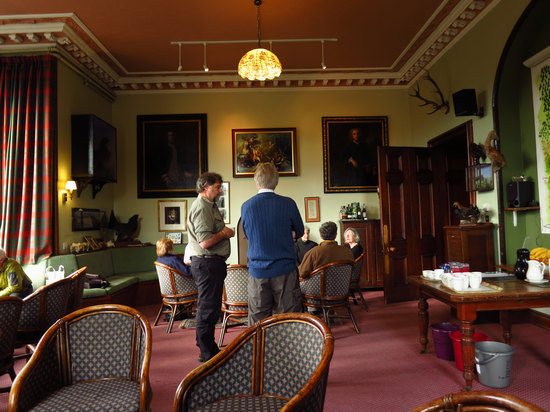
Here is a look at the common room where we had out first cup of coffee in the morning as well as our afternoon tea and happy hour drinks. It was very cozy, especially when there was a nice fire going.
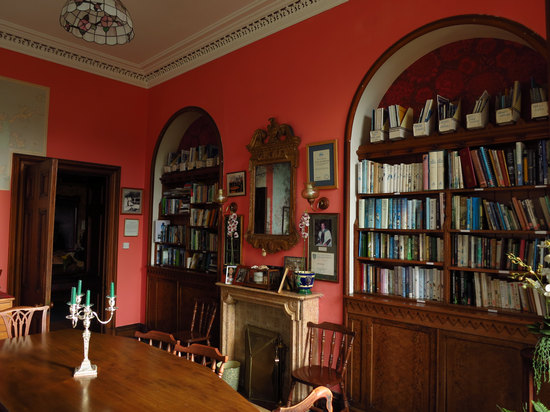
Adjacent to the common room was the library. It contained an excellent selection of natural history books for the UK and some for the U.S.
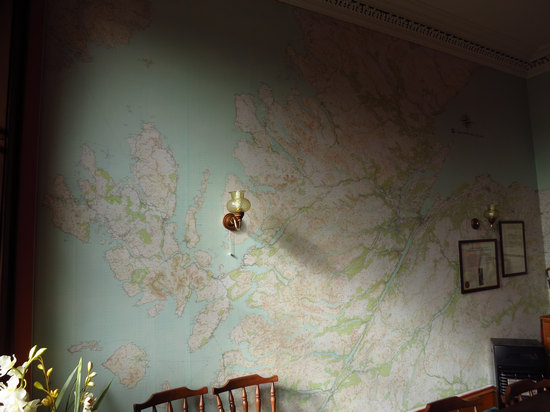
And the library had some really cool wallpaper! It was fun browsing the map after one of the field trips to see where we had just been and in anticipation of trips to come.

Here is a photo which was previously posted
on our first day at Aigas Field House.

Now with only Ellie and Chris in attendance,
the dining hall looks a bit different.

There is a "cat walk" above the dining hall which has more books
and more interesting natural and cultural artifacts.
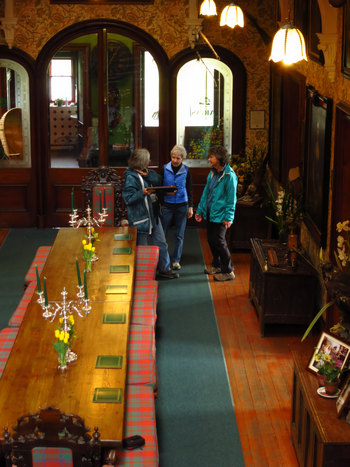
Ellie, Lynn and Betsy look over one of the
objet d'art which was on disply in dining hall.
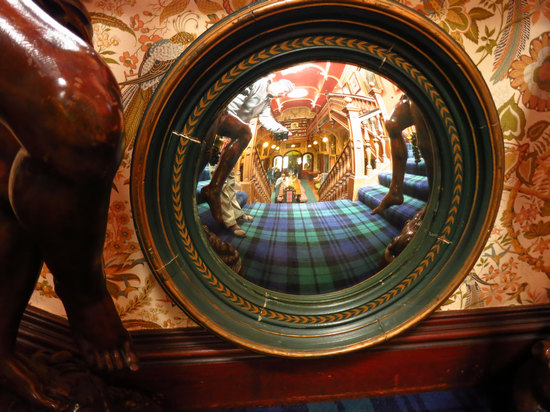
This wood framed convex mirror was at the top of the dining hall steps. It gave an interesting perspective to the hall.
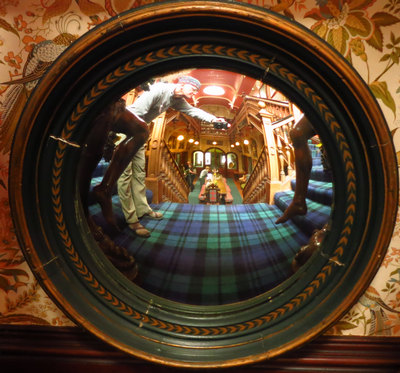

The Lister-Kaye family lives on the second floor of Aigas House. Here, Lucy, John's wife shows off her AGA cooker .
Lucy plays an important part at Aigas house: she sees to it everyone is fed - and fed well! Of course the main kitchen is down stairs and adjacent to the dining hall.
The AGA cooker is a heat storage stove and cooker, which works on the principle that a heavy frame made from cast iron components can absorb heat from a relatively low-intensity but continuously-burning source, and the accumulated heat can then be used when needed for cooking.
Originally heated by slow-burning coal, the Aga cooker was invented in 1922 by the Nobel Prize-winning Swedish physicist Gustaf Dalén (1869–1937), who was employed first as the chief engineer of the Swedish AGA company (Swedish: Aktiebolaget Svenska Gasaccumolator, English: Joint stock company Swedish Gas Accumulator). The cookers were first imported to Britain in 1929, and were first manufactured there under licence in the early 1930s.
The cast iron components were first cast at the Coalbrookdale foundry in the 1940s, where they are still made today by the Aga Rangemaster Group.
Source: WikiPedia

Every morning we were served up steaming bowls of Pinhead Porridge. Lucy was well aware some of us Americans might not know the difference between the porridge we were served up at Aigas house and the oat meal we were used to eating at home.
As a visual aid she had set up these two bowls in her kitchen.
On the left we have uncooked Pinhead porridge and to the right is steel cut oats. The latter is what Betsy and I eat when we have oatmeal.
I am still not sure of the exact difference between the two as it relates to the processing of the oats. They are quite different looking, but why I do not know.

We moved from the kitchen to the grounds where Warwick pointed out various architectural features of Aigas House. This is the "business end" of the house where one enters a foyer with cloak room which leads to the drawing room and dining hall. Access to the kitchen and delivery area is also from this side.
Remember, when John Lister-Kaye first saw this house it was in ruins and scheduled for demolition.
After World War II the Gordon-Oswalds died out and the house and estate suffered in the deep depression which hit the Highlands in the 50s.
Aigas changed hands several times, was split up into smaller units and the house became an Old Folks Home, requisitioned by the Inverness-shire County Council to house a whole generation of elderly Highlanders who had lost their men folk in two world wars and had no-one to look after them. It was an unhappy era that lasted until 1971 when it was closed down and left empty. By 1975 it was considered unsafe and plans were prepared to demolish it.
Source: History of the House of Aigas
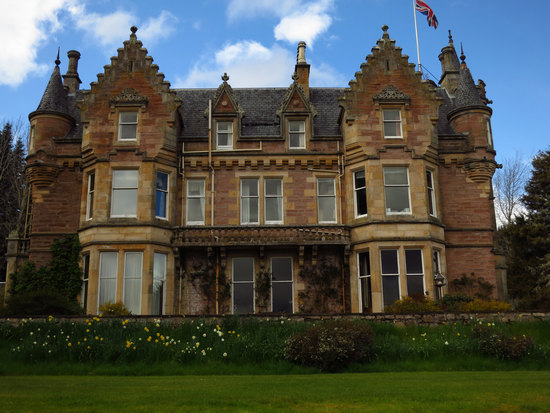
Here is the facade of Aigas house. It faces the main road and presents a grand view of the house for all those who pass by.

Over the years Lucy has transformed the grounds adjacent to Aigas House. I took this photo to show the hedge which is sheared European Beech (Fagus sylvatica). I had seen pictures and read accounts of this tree being used for hedging but this is the first time I had ever actually seen it in the landscape.
There is much, much more to see around the house. But, being off my game I did not take that many photos. Next time...

After we got back in from the field we always had tea and cakes followed by pre dinner drinks. This fellow was there to greet us at Happy Hour.
Betsy really enjoyed the kilts!
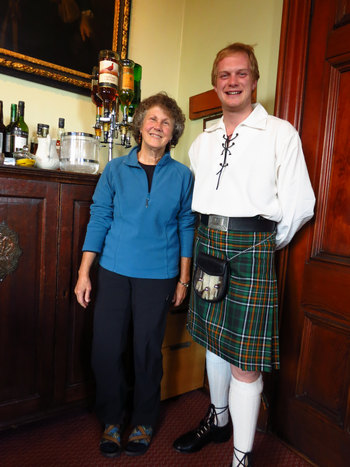
Here, Ranger Scott sports the traditional garb of the Highlands.
The term highland dress describes the traditional dress of Scotland. It is often characterised by tartan (plaid in North America) patterns in some form.
Male highland dress includes kilt (or trews), sporran, sgian dubh and ghillies. Ghillies, or ghillie brogues, are traditional thick soled shoes with no tongues and long laces. The laces are wrapped around and tied above the wearer's ankles so that the shoes do not get pulled off in mud. The shoes lack tongues so the wearer's feet can dry more quickly in typically damp Scottish weather. The ghillie brogue is named after the ghillie, the traditional Scottish gamekeeper and outdoorsman.
In 1618, a poet from London, John Taylor described the costume of Scottish aristocrats, lairds, and their followers and servants, dressed for hunting at Braemar. "In August and September, all classes dressed in the same fashion by custom, as if equals. This included tartan stockings and jerkins, with garters of twisted straw, and a finer plaid mantle round their shoulders. They had knotted handkerchiefs at their necks and wore blue caps. Taylor said the tartan was "warm stuff of diverse colours."
Source: WikiPedia

One could spend many hours here with the comfort
of a good book, a bottle and warm fire.

My daily Happy Hour choice was a local brew from the Black Isle.

Every day we looked forward to our dinner. Lucy and her staff made sure we were well fed. They made us feel like royalty!
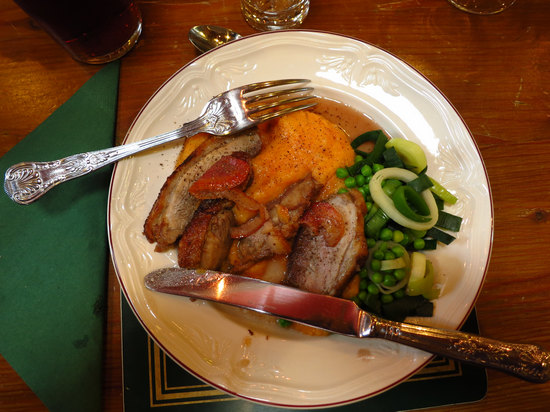
Dinner conversation was always interesting and often lively. It often turned to esoteric discussions about things like the anatomical structures of various critters.
On this day it was about temporal bones in seals. This led to further discussion in the drawing room which had all manner of natural history artifacts to aid in the discussion.

Close examination of several skulls led to a conversation that was a bit out of my depth.

I think it may have been out of Ranger George's depth as well!
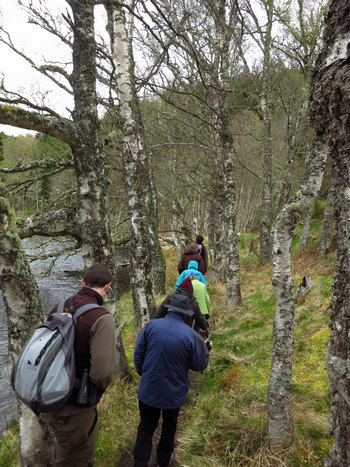
Just up the hill from the house is Aigas Loch with a nice path around it. It's a great place for a nature walk or an early morning stroll.
On this day Ranger George was leading the walk and Ranger Duncan was bringing up the rear. Everyone had "heads down" as the footing is uneven on some parts of the path.
The Aigas Loch, Loch Cuil Na Caillich (loch of the nook of the old woman), is a freshwater loch set amongst shady woodland and open moorland scenery. At its deepest, it reaches a depth of 30 ft. The natural loch was extended by the Victorians in the late 1800s when they added a dam to stabilize the water level, and this has supplied all the water needs of Aigas for over 100 years!
Source: © 2013 Aigas Field Centre

George is pointing out a shelf fungus on the Silver Birch (Betula pendula).
The fungus is commonly known as Birch Polypore or Razor Strop (Piptoporus betulinus).
Piptoporus betulinus, commonly known as the birch polypore, birch bracket, or razor strop, is one of the most common polyporous bracket fungi and, as the name suggests, grows almost exclusively on birch trees. The brackets burst out from the bark of the tree, and these fruiting bodies can last for more than a year. Technically, it is an edible mushroom, with a strong, pleasant "mushroomy" odor but a bitter taste. The velvety cut surface of the fruiting body was traditionally used as a strop for finishing the finest of edges on razors. It is also said to have medicinal properties, and this fungus was carried by "Ötzi the Iceman" – the 5,000 year old mummy found in Tyrol.
Source: WikiPedia

The fields above the Glen were thick with Bracken Fern. I would love to have seen this a month later!

Seeing this evidence of beaver would not be a big deal in the U.S. But, here in Scotland it is a different story.
Until the 16th Century, beavers lived throughout Scotland. They were hunted to extinction for their fur and a glandular oil (castoreum) secreted from the base of their tail containing medicinal properties. In medieval times, castoreum was used as treatment for headaches.
Source: The Scottish Wildlife Trust
Here at Aigas they are participating in the reintroduction of beavers to Scotland.
The foundations of the Scottish Beaver Trial are built upon vast amounts of research into beaver ecology. Beaver reintroductions have successfully taken place in 24 European countries and during the Scottish Beaver Trial, new and original data will be collated to provide further information about the impact of beavers on the local environment - as well as the local economy.
Source: The Scottish Wildlife Trust
The Beaver population was not the only thing to be decimated in Scotland. The Caledonian forest, estimated to have once covered nearly 4,000,000 acres has now been reduced to a mere (44,000 acres) in 84 locations. One of the locations is Glen Affric which we were fortunate enough to visit.

Dog Falls parking area was the starting point for our walk through a remnant Caledonian Forest.

When I decided to have my sandwich here at the parking area a Chaffich decided to join me.
This bird is widespread and very familiar throughout Europe. It is the most common finch in western Europe, and the second most common bird in the British Isles. Its range extends into western Asia, northwestern Africa, and Macaronesia, where it has many distinctive island forms. In the Canary Islands of Tenerife and Gran Canaria, the Common Chaffinch has colonised twice, giving rise to the endemic species known as the Blue Chaffinch and a distinctive subspecies. In each of the Azores, in Madeira, and in the rest of the Canaries there is a single species on each island.
It was introduced from Britain into a number of its overseas territories in the 18th and 19th centuries. In New Zealand it is a common species. In South Africa a very small breeding colony in the suburbs of Constantia, Hout Bay and Camps Bay near Cape Town is the only remnant of one such introduction.
It uses a range of habitats, but open woodland is favoured, although it is common in gardens and on farmland.
Source: WikiPedia
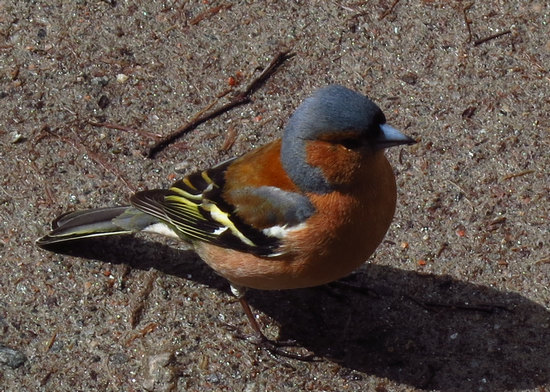
Quite a pretty little bird. Nice of him to pose for me.

Before starting on our walk Ranger Kate gave us a little back ground on the history of the area.

Like all the Rangers at Aigas, Kate had a thorough knowledge of the flora and fauna of the area. Here she has collected a specimen of one of the heather species to show us.
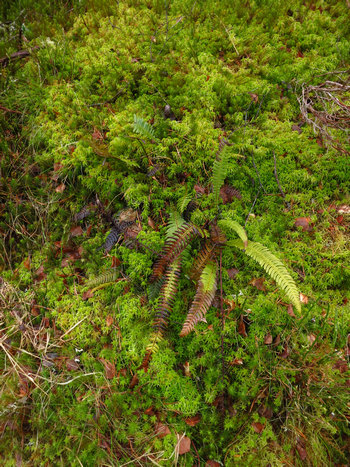
These are last year's fronds of the Hard Fern (Blechnum spicant). The plant is growing in a mat of Sphagnum moss. The Sphagnum looks like it has new growth but the Blechnum is stone cold dormant. In fact it looked like the middle of winter here at Glen Affric and it was late May.

I spotted this beauty and picked it up to better show it to everyone. I had never seen a solid black slug before. Gorgeous!
The size of the slug varies from 10 to 15 cm. Maturity is reached at about 2.5 cm.
The color of the black slug is generally black, but the colouration is very variable and this slug can even be white. The general trend is for a darker pigmentation the farther north the species is found. The classification of brown-coloured and rust-coloured "black" slugs is somewhat disputed; the brown variation is sometimes considered to be a separate species, Arion rufus (Red Slug). Young specimens of black slug do have a brown colour, which is later lost if and when the slug changes color to the mature state.The slug covers itself in a thick foul-tasting mucus which serves as both protection against predators as well as a measure to keep moist. It is somewhat difficult to wash off.
Source: WikiPedia

This medley of mosses and heather made for a nice picture.

The way Bart and Adel are bundled up gives you
an idea of the weather on that day. Brisk!

I spotted this on the side of the road. It was similar to a railroad spike, but smaller and thinner. Do you know what it might have been used for?
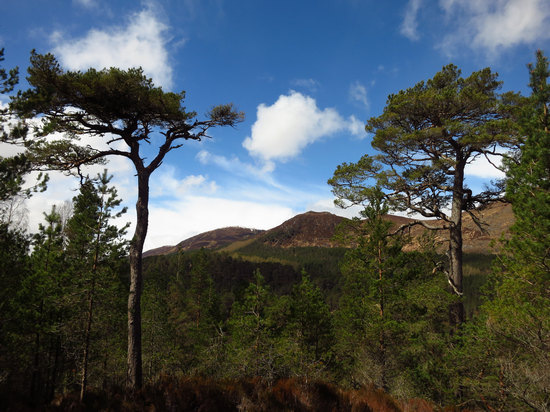
These are the lovely Scots Pine of the Caledonian Forest. These old trees are known affectionately as Granny Pines. I image these trees are well over a 100 years old.
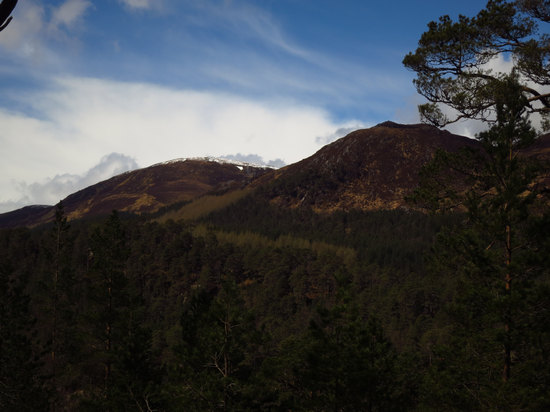
To the left you can see snow on the mountains. In fact, it spit snow on this hike. Thankfully it did not last.
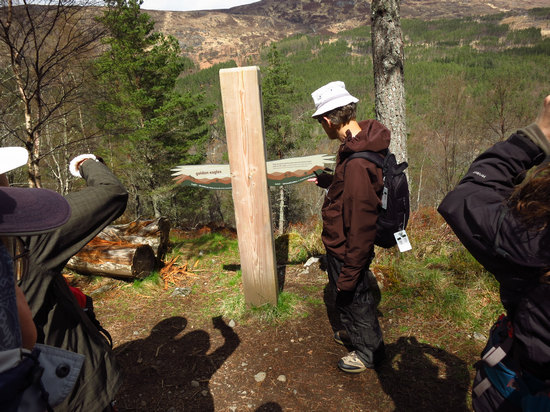
Steve checks out the "tilt sign". When you let go, the signs fall back into a slot milled into the post. Cleaver. This sign talks about the Golden Eagles which nest in the area.
Unfortunately these birds are being killed by some members of the Scottish Gamekeepers Association (SGA) because they are known to prey on grouse.

The delicate Wood Anemone (Anemone nemorosa) was in bloom in many of the places we visited.
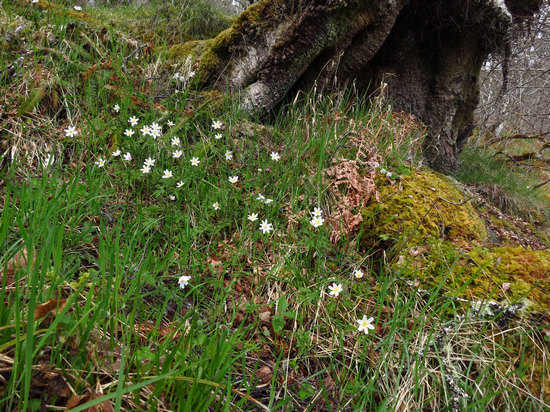
This Wood Anemone was growing at the base of an ancient Silver Birch.
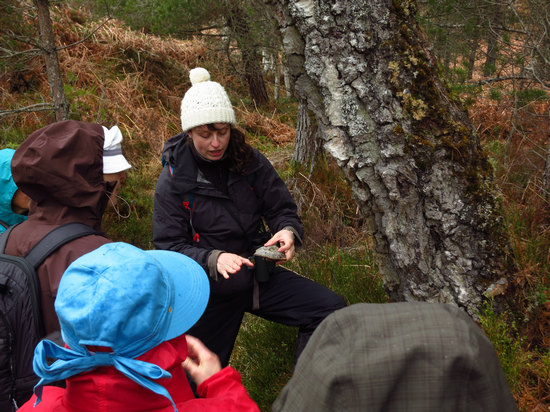
Here Kate gives us a refresher course on the Birch Polypore which was previously talked about by Ranger George.

Here we are at the roaring Dog Falls of the River Affric.
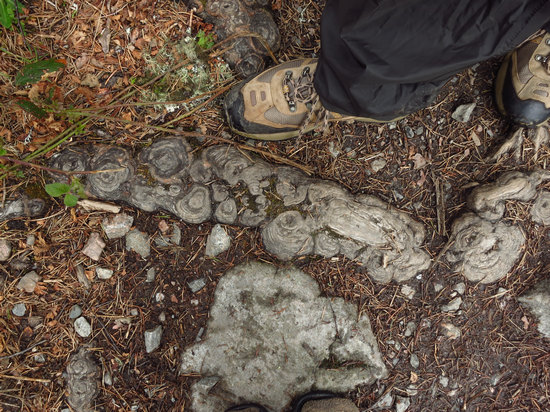
These scuffed and calloused tree roots are evidence of the many thousands of feet that have passed this way.
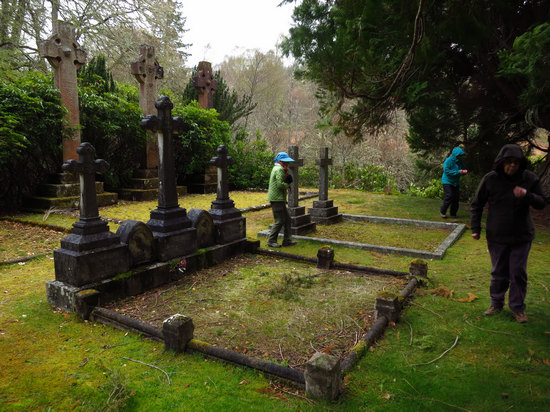
On our way back to Aigas House we stopped at the Chisholm family graveyard with its celtic crosses. This cemetery is near Struy which is about 5 miles west of Aigas Field Centre.
Bundled up and huddled against the wind and rain, our thoughts now turned to the hot tea and crumpets which awaited us upon our return to Aigas House.
According to a 19th-century historian, Alexander Mackenzie, the Clan Chisholm is of Norman and Saxon origin. Tradition stating that the Chisholms were a Norman family who arrived in England after the Norman conquest of 1066. The original Norman name being De Chese to which the Saxon term "Holme" was added upon the marriage of a Norman ancestor to a Saxon heiress. In early records the name is written as "de Cheseholme", eventually later becoming Chisholm. In Scotland the earliest recorded person of the family is on the Ragman Rolls as "Richard de Chisholm del Counte de Rokesburgh", referring to the Clan Chisholm's seat in Roxburghshire.
Source: WikiPedia

A wolf's head and ferns - the Crest of Clan Chisolm
The Clan Chisholm
Feros Ferio - 'I am fierce with the fierce'
It is most likely that the first de Chesholme was one of the knights of William the Conqueror, arriving in England in1066. Scottish society, in the 150 years following the Norman conquest was a crucible in which two dynamic cultures, Celtic and Anglo-Norman were increasingly intermingled. Out of this the fiercely independent Scots character was formed.
David I was the youngest of the three sons of Malcolm Canmore and Saint Margaret - the sister of Edgar Atheling - grew up at the Norman court, where his sister had married Henry I. David had a policy of gaining the allegiance of Norman knights by giving them tenancies in areas under his jurisdiction. According to clan tradition one of these knights was de Chesholme. By the end of the thirteenth century the de Chesholmes were prominent in David’s early territories around Roxburgh and Berwick.Source: © glenaffric.org 2011

The Chisholm cemetery had the largest Yew (Taxus baccata) I had ever seen. Care to guess the age?
It is relatively slow growing, and can be very long-lived, with the maximum recorded trunk diameter of 4 metres probably only being reached in about 2,000 years. The potential age of yews is impossible to determine accurately and is subject to much dispute. There is rarely any wood as old as the entire tree, while the boughs themselves often hollow with age, making ring counts impossible.
There are claims as high as 5,000–9,500 years, but other evidence based on growth rates and archaeological work of surrounding structures suggests the oldest trees (such as the Fortingall Yew in Perthshire, Scotland) are more likely to be in the range of 2,000 years.
Even with this lower estimate, Taxus baccata is the longest-living plant in Europe. One characteristic contributing to its longevity is that it is able to split under the weight of advanced growth without succumbing to disease in the fracture, as do most other trees.Source: WikiPedia
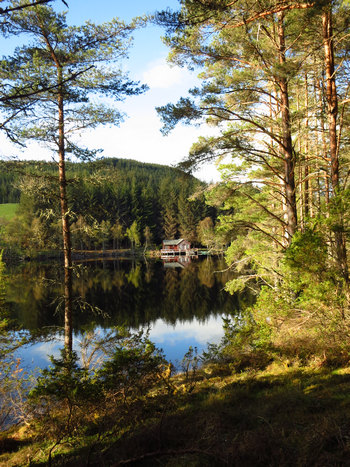
On our last morning at the Aigas Field Centre I took an early morning walk up to the loch and hills surrounding it. I took several photos of the rustic guest house which has been dubbed "The Illicit Still". Legend has it there was indeed an illicit still here at one time.

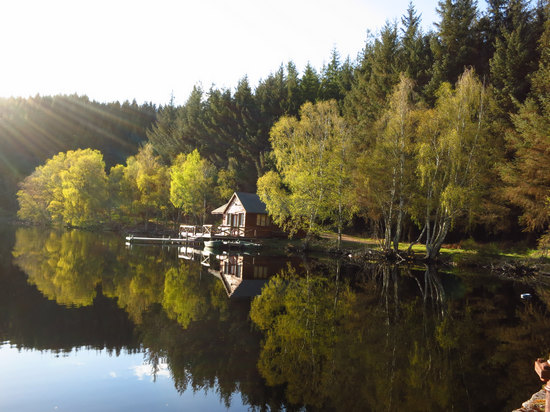
Wouldn't this be a nice spot to spend a leisurely morning?
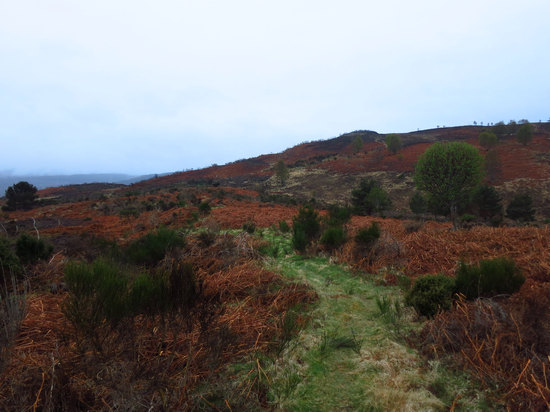
Leaving the loch behind I walked the path up to the open heather moor. The brown plant is the ubiquitous Bracken Fern which grows amongst the heather and gorse.
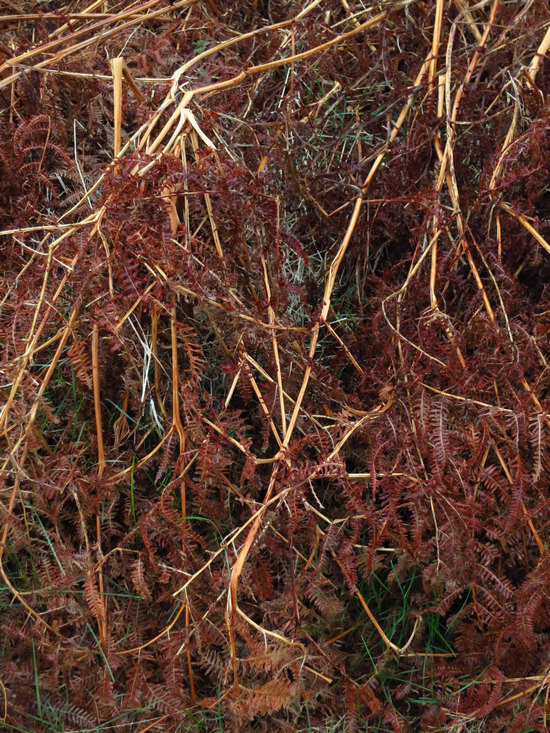
These dead fronds, now nearly a year old, have formed quite a thick ground mat.

Based on some of the disparaging remarks by the Rangers, I got the distinct impression the lowly Bracken Fern is not well liked because it is such an aggressive spreader.
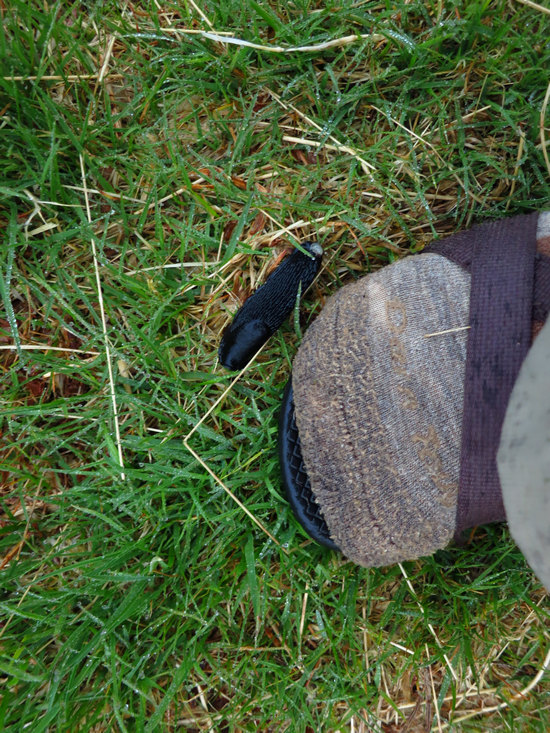
When I saw the black slugs at Glen Affric
I did not realize they were so abundant.
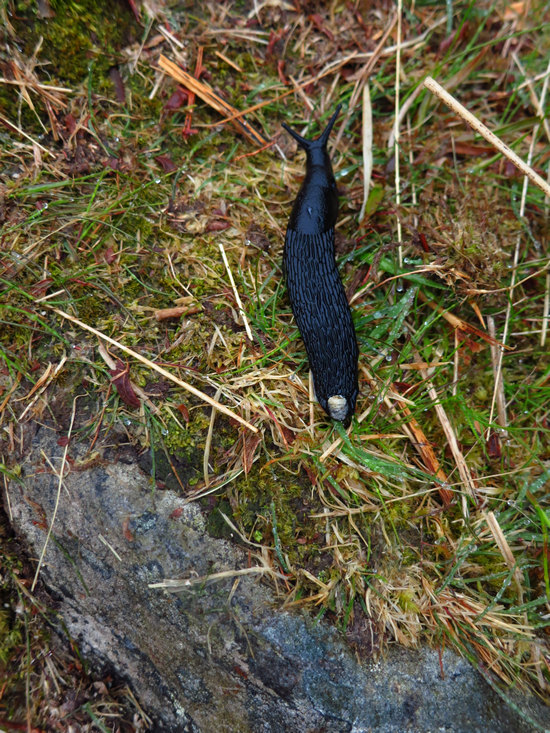
I saw so many on my morning walk, I lost count.

This fella almost matches my Chaco!
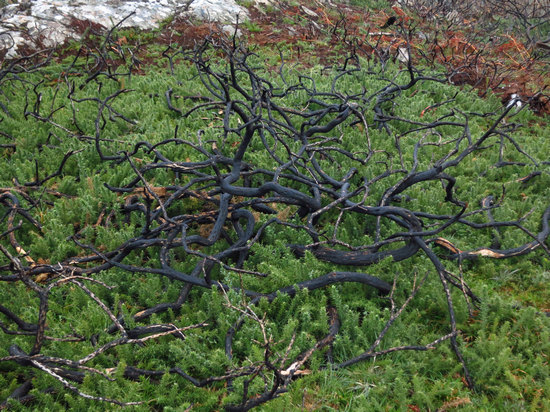
Ranger Duncan told us about a fire here that he helped extinguish. There were real concerns about it reaching the conifer planting and wildlife hides. Fortunately it was put out in time to prevent this.

At the summit above the loch I got a good look at the River Glass and distant, snow covered highlands.
The River Glass (Scottish Gaelic: Abhainn Ghlais) is a river in the Scottish Highlands which flows northeastwards down Strathglass. It begins at the confluence of the River Affric and the Abhainn Deabhag, near the village of Tomich. It is joined by the River Cannich near the village of Cannich, then flows as far as a confluence with the River Farrar near Struy, from which point the merged waters are known as the River Beauly.
Source: WikiPedia
Although barely visible in the photo above, there is a power line which runs through the Glen and is clearly visible from Aigas House. This is the Beauly Denny overhead power line upgrade, which includes a series of 600 new pylons, some towering more than 200ft high. This replaced an older power line which had much smaller pylons and thus a minimal impact on the landscape.
As you can imagine there were some folks who didn't like the idea of this project going through their backyard. One such person was millionaire Brendan Clouston. He tried to stop the project but failed. See: " Millionaire tries to shut down Scottish power line plans by refusing to sell tiny strip of land needed for energy project" for more details.
The Beauly Denny power line upgrade was built to transmit renewable energy generated in the Highlands and Islands to the central belt.
However, there are some who would say this is just another example of ruining the wild areas so the big cities and factories can have as much power as they want to use. And, the "renewable energy" mentioned above is from industrial wind turbine arrays which are being forcibly subsidized by the people of the UK.
This article about wind "farms" makes for some interesting and thought provoking reading.
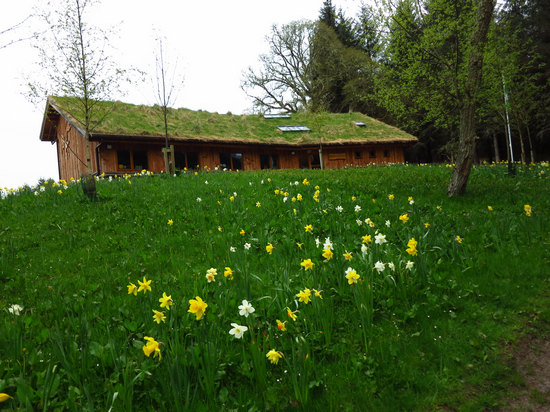
On the way back from my early morning walk I passed by The Magnus House which is situated between the loch and Aigas house.
The Magnus House is our new purpose–built facility for environmental education at Aigas. It is designed to inspire and educate minds of all ages in nature and the environment.
Named after Magnus Magnusson, a close friend of Sir John Lister-Kaye, the building is designed to be eco-friendly as well as child–friendly. The main structure is built using locally-sourced sustainable timber, of larch cladding for the outer walls and pine inside. The stone for the low outside walls was sourced from our local quarry and Caithness slab-stones make up the path work and window ledges...
Source: Nature Days at Aigas
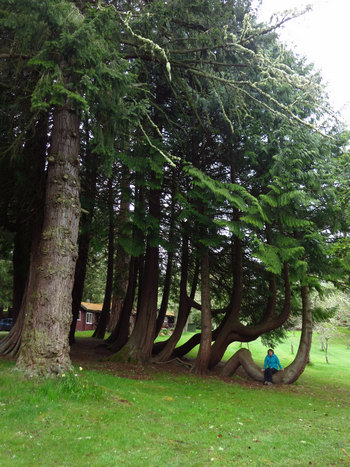
Every time Betsy and I walked up to our cabin, Magnus House or loch we passed by many magnificent conifers which were planted when Aigas was a Victorian sporting estate. This being our last morning at Aigas meant it was also my last chance to get photos of some of these beauties.
These are Red Cedar (Thuja plicata)

Amazing!
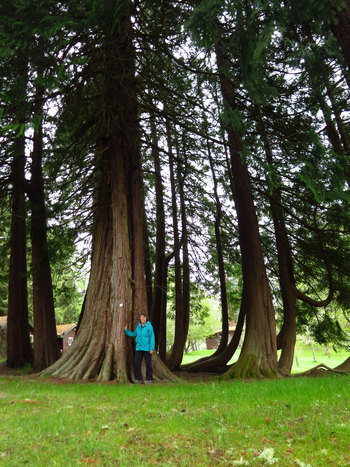
Note the buttressed trunk.
"Buttresses, lateral flanges joining the roots and the trunk,
have intrigued generations of biologists..."

Here is a nice specimen of the coast redwood or
California redwood (Sequoia sempervirens).
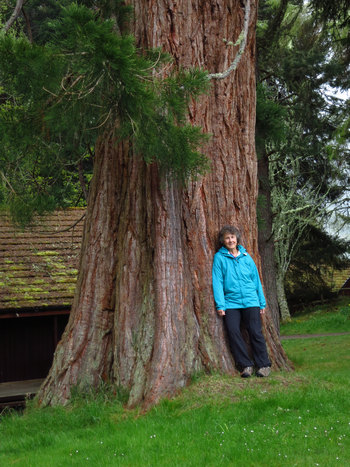
Two beauties!


Grand indeed!
The Grand Fir (Abies grandis), like most of the other specimen trees here is native to the Pacific Northwest and Northern California of North America.
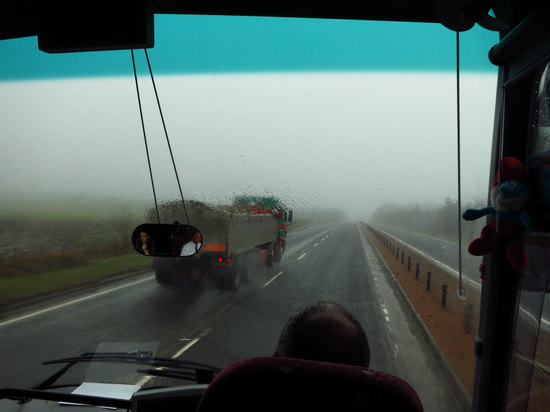
After saying farewell to both our trees and human friends we were on the bus and headed down the road to Glasgow. The weather looked remarkably similar to our bus ride north to Aigas 10 days previous.
On the trip to Glasgow we made several stops and were educated and entertained by the information Rangers Duncan and George imparted.
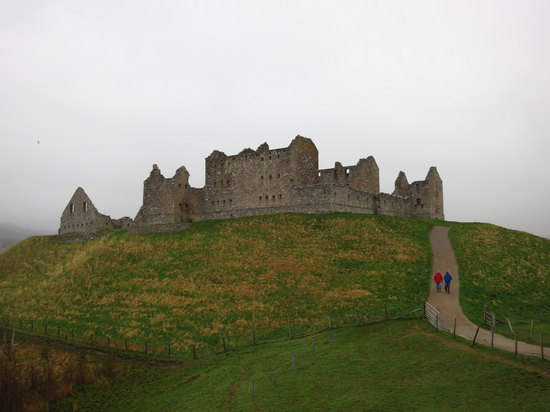
One of our stops was Ruthven Barracks.
Ruthven Barracks near Ruthven, Highland in Scotland are the smallest but best preserved of the four barracks built in 1719 after the 1715 Jacobite rising, set on an old castle mound. It comprises two large three-storey blocks occupying two sides of the enclosure each with two rooms per floor. The barracks and enclosing walls were loopholed for musket firing, and bastion towers were built at opposite corners. The Barracks are maintained as an Ancient Monument by Historic Scotland and are accessible at all times without entrance charge.
The first castle recorded to have been built on this site appeared in 1229. By 1379 it formed the centre of activity of Alexander Stewart, 1st Earl of Buchan and younger son of King Robert II of Scotland. Alexander is better remembered as the Wolf of Badenoch. He is notoriously remembered for falling out with the bishop of Moray and in retaliation destroying Elgin Cathedral and much of Elgin in 1390. The first castle at Ruthven was destroyed in 1451, but a second castle was re-built in its place in 1459 as a much grander fortification.
Source: WikiPedia

The rainy, cold and blustery weather did not deter us from poking into all the nooks and crannies of this interesting place.

Anyone trying to ascend the exposed hill for an attack probably did not get very far.

Barracks life: ten to a room and two to a bed. Click to read the sign.

This area was tough to defend and hold. This sign tells more about that story.
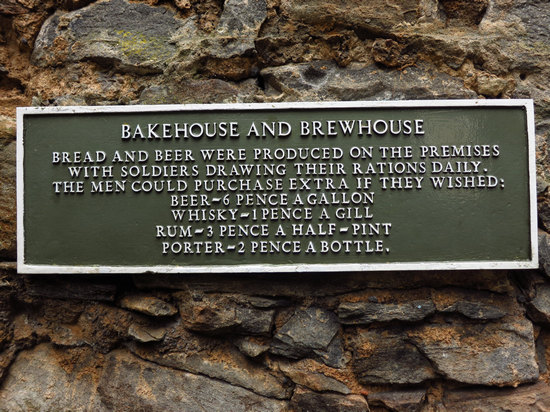
Gotta keep the troops well fed and happy!
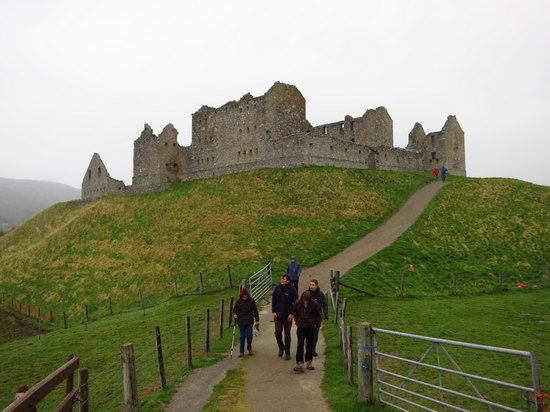
A parting shot of the barracks. Imagine hauling all that stone up there during construction!
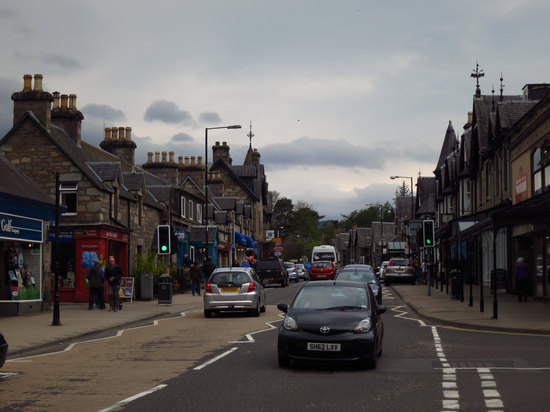
We then stopped in the town of Pitlochry, a quaint tourist trap which is nicely situated along the Tummel River in the hill country of Perth and Kinross.
Pitlochry (Baile Chloichridh or Baile Chloichrigh) in Gaelic), is a burgh in the council area of Perth and Kinross, Scotland, lying on the River Tummel. Its population according to the 2001 census was 2,564.
It is largely a Victorian town, which developed into a tourist resort due to Queen Victoria visiting the area in 1842, and the arrival of the railway in 1863. It remains a popular tourist resort today and is particularly known as a centre for hillwalking, surrounded by mountains such as Ben Vrackie and Schiehallion. It is popular as a base for coach holidays. The town has retained many stone-built Victorian buildings and the main street has an unusual period cast iron canopy over one side.
Source: WikiPedia
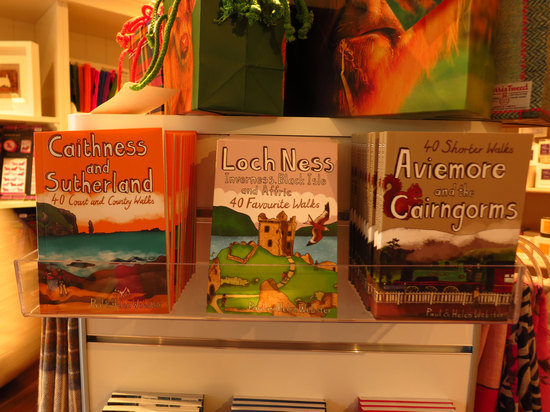
Like most tourist towns, one of the main forms of recreation is shopping. Pitlochry is no exception. Maybe some day Betsy and I will be back, purchase these hiking guides and then put them to good use.
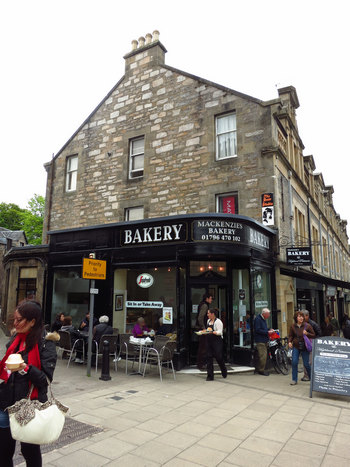
Time for lunch! While Duncan waited in line to place our order I stayed outside and dodged shoppers.

Mission accomplished! Hot blood sausage sandwiches.
Yummy!

This nicely designed sign whet our appetite for some hiking. But, it will have to wait...

We caught a break in the rain while at Pitlochry but it didn't last.

Here, Duncan and the congenial bus driver share a laugh.

Nasty driving conditions.

Our last stop before arriving in Glasgow was a rest stop with a huge tourist shop. Here, they sold all things Scottish including Flapjack.
While at Aigas we had several bag lunches which included Flapjack. I tried it but did not care for it - too rich. No wonder, the butter content is 25%!
In the UK, the Isle of Man and Ireland, and Newfoundland a flapjack is a baked bar, cooked in a flat oven tin and cut into rectangles, made from rolled oats, fat (typically butter), brown sugar and usually golden syrup.As well as being baked at home, they are widely available in shops, ready-packaged, often with extra ingredients such as chocolate, dried fruit such as glace cherries, nuts, yoghurt and toffee pieces or coatings, either as individual servings or full unsliced trayfuls.
A variant of them available in shops in the United Kingdom is known as the "Bakewell flapjack". Some flapjacks may contain maple. They are usually an alternative to a biscuit (cookie) or cake, and textures range from soft and moist to dry and crisp.[1] Because of the high levels of fat and calories in traditional recipes, some "diet" versions are available with lower fat and calorie content. Similar products are known in Australia as muesli bars or simply 'a slice'. Similar products in North America are Hudson Bay Bread and granola bars.
Source: WikiPedia

Translation: Highland Cow poop patties.

Poor Nessie - how degrading!

Finally, Betsy gets to try on a kilt!
And, that is that, the end of our first trip to Scotland and a memorable one it was.
Many thanks to Betsy, our fellow Road Scholars and the staff at Aigas for such a wonderful visit.
'Till next time...